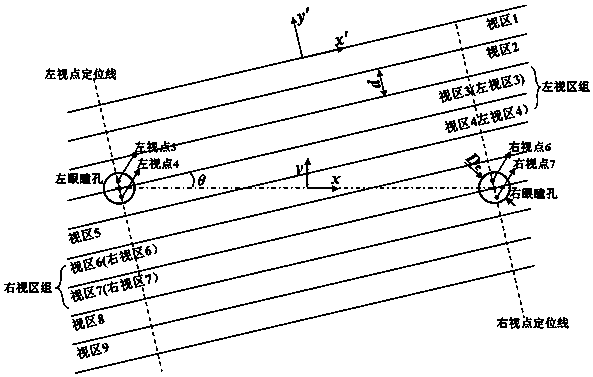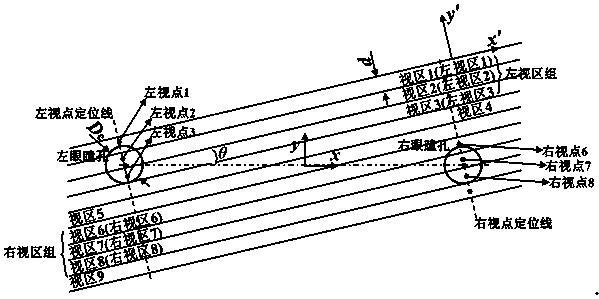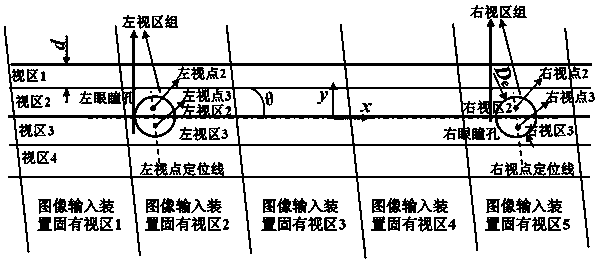Grating-based three-dimensional display method
A three-dimensional display and grating technology, applied in the direction of optics, optical components, instruments, etc., can solve the problems of observers' dizziness, inconsistency between focus distance and convergence distance, and the inability to realize single-eye multi-view presentation, etc., so as to improve the display effect and improve The effect of display resolution
- Summary
- Abstract
- Description
- Claims
- Application Information
AI Technical Summary
Problems solved by technology
Method used
Image
Examples
Embodiment 1
[0040] A grating-based three-dimensional display method of the present invention utilizes a one-dimensional grating to split light beams emitted by pixels of a display screen. A one-dimensional grating is placed in front of the display screen along the transmission direction of the light emitted by the display screen. The one-dimensional grating splits the light beams emitted by the pixels of the display screen, so that different groups of pixels can be seen in different viewing areas, such as figure 1 Viewports 1, 2, 3, 4, 5, 6, 7, 8 and 9 are shown. The grating parameters of a one-dimensional grating make the distance between adjacent viewports along the vertical direction of the grating unit length d Larger, the observer's pupil cannot completely cover a complete viewing area. at point in time t + l ×∆ t ( l is a natural number), and determine the spatial position of the observer's pupils through tracking and positioning. According to the position of the observer's p...
Embodiment 2
[0042] A grating-based three-dimensional display method of the present invention utilizes a one-dimensional grating to split light beams emitted by pixels of a display screen. A one-dimensional grating is placed in front of the display screen along the transmission direction of the light emitted by the display screen. The one-dimensional grating splits the light beams emitted by the pixels of the display screen, so that different groups of pixels can be seen in different viewing areas, such as figure 2 Viewports 1, 2, 3, 4, 5, 6, 7, 8 and 9 are shown. The grating parameters of a one-dimensional grating make the distance between adjacent viewports along the vertical direction of the grating unit length d smaller than observer's pupil diameter D e , in this case, as long as the pupil within the viewing area is within the distribution range of the viewing area, it can at least partially overlap with two or more viewing areas. at point in time t + l ×∆ t ( l is a natural n...
Embodiment 3
[0044] A grating-based three-dimensional display method of the present invention adopts a display device capable of projecting different images to the eyes of an observer as an image input device. The image input device realizes the presentation of binocular different images through light-splitting technology, for example, the light is split by an inherent grating attached to the display screen of the image input device. The viewports generated by these image input devices are named as the intrinsic viewports of image input devices, such as image 3 Among the image input device proper viewing areas 1, 2, 3, 4 and 5, images displayed by different groups of pixels on the display screen can be received in different image input device proper viewing areas. Then place a one-dimensional grating in front of the display screen along the transmission direction of the light emitted by the display screen, and the one-dimensional grating splits the light beams emitted by the pixels of the...
PUM
 Login to View More
Login to View More Abstract
Description
Claims
Application Information
 Login to View More
Login to View More - Generate Ideas
- Intellectual Property
- Life Sciences
- Materials
- Tech Scout
- Unparalleled Data Quality
- Higher Quality Content
- 60% Fewer Hallucinations
Browse by: Latest US Patents, China's latest patents, Technical Efficacy Thesaurus, Application Domain, Technology Topic, Popular Technical Reports.
© 2025 PatSnap. All rights reserved.Legal|Privacy policy|Modern Slavery Act Transparency Statement|Sitemap|About US| Contact US: help@patsnap.com



